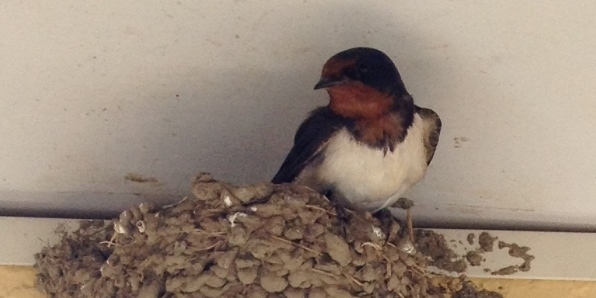Less pigmented female swallows have warm brood patches, as revealed by infrared thermometer.
LINKED PAPER
High brood patch temperature of less colourful, less pheomelanic female Barn Swallows Hirundo rustica. Hasegawa, M., Arai, E., Ito, S. & Wakamatsu, K. 2016. IBIS DOI: 10.1111/ibi.12405 VIEW
In many passerine birds, females develop brood (incubation) patches to allow effective heat transfer from the adult to the egg clutch (Lea & Klandorf 2002). In contrast, male passerines often lack a brood patch and so in many species, males do not function as a perfect substitute for female incubation.
Effective incubation is indispensable to ensure high breeding success, so males should pair with females that can achieve a high egg temperature during incubation. But, unfortunately, males are unable to use direct cues about incubation at the time of pairing, because females develop brood patches long after pair formation. Males should therefore focus on a different female trait that is an indicator of egg temperature.
Some empirical studies have recently demonstrated that melanin-based plumage colouration correlates with body temperature (Ducrest et al. 2008). So, we predicted that melanin-based colouration should also correlate with female brood patch temperature. To test this prediction, we chose the Barn Swallow Hirundo rustica as our model species (Fig. 1). Female Barn Swallows almost certainly incubate all night and females contribute more than 90% of diurnal incubation. We studied brood patch temperature of female swallows in relation to the melanin-based throat coloration. Because Barn Swallows nest under the eaves of houses in our study population, as in other Japanese populations (subspecies: H. r. gutturalis), female brood patch temperature may be particularly important, compared with colonial populations in warm livestock stalls (Turner 2006).

We captured incubating female swallows at night (during 23:00-03:00). We measured plumage characteristics and brood patch temperature using an infrared thermometer (Fig. 2). The concentration of pheomelanin in the feathers was determined in the lab later.

© Masaru Hasegawa
After statistically controlling for confounding factors, we found that less colourful, less-pheomelanic females had warmer brood patches. As predicted, (pheo-)melanin pigmentation was related to brood patch temperature in female swallows. To our knowledge, this is the first study to show that female ornaments can predict the thermal investment in brood patches.
Our finding is consistent with the genetic linkage between melanin-based coloration and body temperature (Ducrest et al. 2008), although further studies are needed to determine the generality of the result. In addition, as proposed in recent studies (e.g., Roulin et al. 2013; Koskenpato et al. 2016), barb density, and thus the extent of thermal insulation, might be lower in more-pheomelanic female swallows. The relative importance of these and other potential explanations require further study.
Do males prefer less-colourful females?
From the current study, we predict that male Barn Swallows choose less-colourful females that can achieve a high egg temperature. Is this in fact the case? Our latest correlative study suggests that this is not the case in the Japanese Barn Swallow, because colourful, rather than less-colourful, females had a mating advantage (Hasegawa et al. 2016; also see Romano et al. 2016 for a recent meta-analysis).
A potential explanation of the discrepancy is that brood patch temperature is less important than other female characteristics. In fact, the current study established that incubation period was not predicted by brood patch temperature, but by female incubation behaviour (Hasegawa et al. 2012). In addition, colourful Barn Swallow females are older and more experienced and hence tend to have greater reproductive output (Hasegawa et al. 2016; Turner 2006). Male mate preferences may be affected by the combinations of these properties rather than by brood patch temperature alone.
References
Ducrest, A.L., Keller, L. & Roulin, A. 2008. Pleiotropy in the melanocortin system, coloration and behavioural syndromes. Trends in Ecology & Evolution 23: 502–510. VIEW
Hasegawa, M., Arai, E., Watanabe, M. & Nakamura, M. 2012. High incubation investment of females paired to attractive males in Barn Swallows. Ornithological Science 11: 1–8. VIEW
Hasegawa, M., Arai, E., Watanabe, M. & Nakamura, M. 2016. Reproductive advantages of multiple female ornaments in the Asian Barn Swallow Hirundo rustica gutturalis. Journal of Ornithology (in press) DOI: 10.1007/s10336-016-1401-z. VIEW
Lea, R.W. & Klandorf, H. 2002. The blood patch. In Deeming, D.C. (ed.) Avian Incubation: Behaviour, Environment, and Evolution: 100–118. Oxford: Oxford University Press.
Koskenpato, K., Ahola, K., Karstinen, T. & Karell, P. 2016. Is the denser contour feather structure in pale grey than in pheomelanic Brown Tawny Owls (Strix aluco) an adaptation to cold environments? Journal of Avian Biology 47: 1–6. VIEW
Romano, A., Constanzo, A., Rubolini, D., Saino, N. & Møller, A. P. 2016. Geographical and seasonal variation in the intensity of sexual selection in the barn swallow Hirundo rustica: a meta-analysis. Biological Reviews (in press) DOI:10.1111/brv.12297. VIEW
Roulin, A., Mangels, J., Wakamatsu, K. & Bachmann, T. 2013. Sexually dimorphic melanin-based colour polymorphism, feather melanin content, and wing feather structure in the Barn Owl (Tyto alba). Biological Journal of the Linnean Society 109: 562–573. VIEW
Turner, A.K. 2006. The Barn Swallow. London: T & AD Poyser.
Image credit
Featured image: A female Barn Swallow on the nest © Masaru Hasegawa
If you want to write about your research in #theBOUblog, then please see here.





